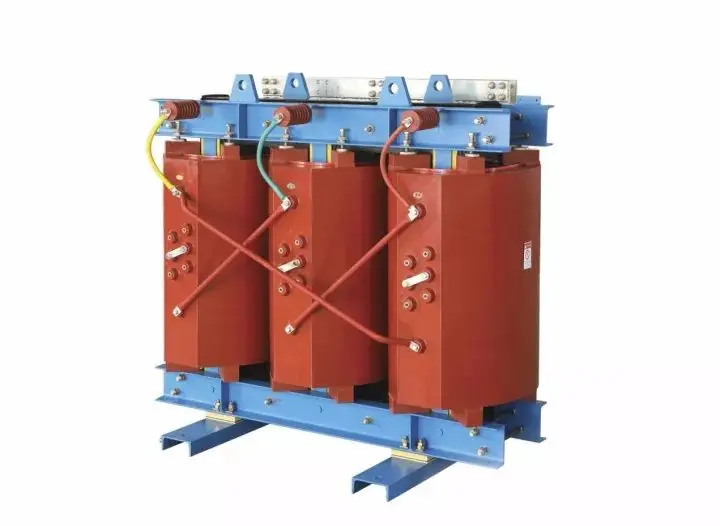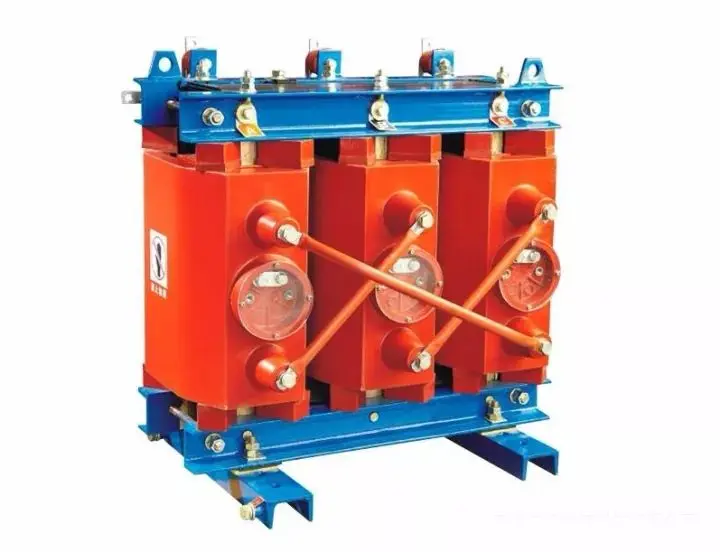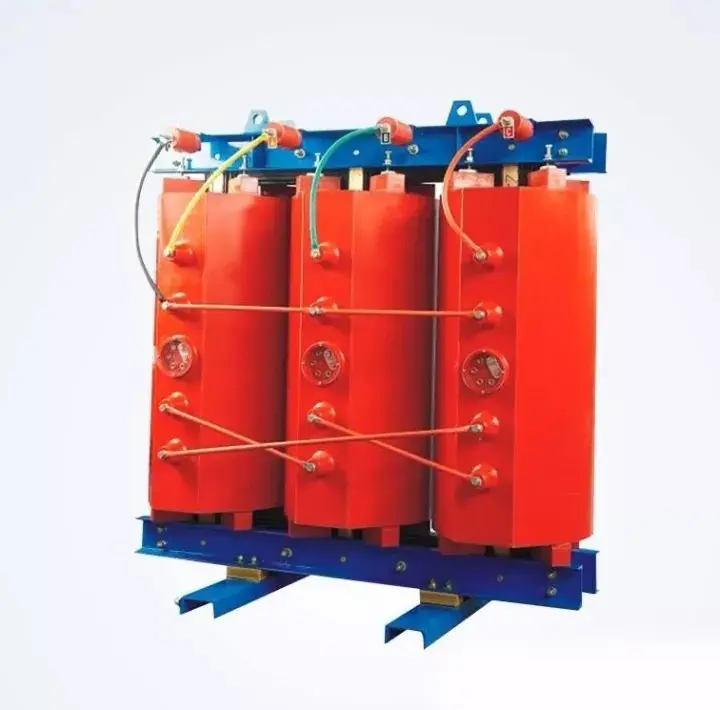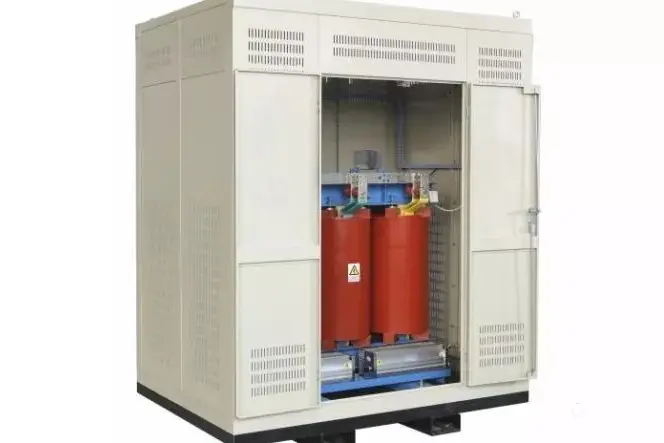
Dry-type transformer
Dry-type transformers are widely used in local lighting, high-rise buildings, airports, docks, CNC machinery and equipment, and other places. Simply put, dry-type transformers refer to transformers whose cores and windings are not immersed in insulating oil. The cooling methods are divided into natural air cooling (AN) and forced air cooling (AF). When the transformer is naturally cooled, it can operate continuously for a long time at the rated capacity. When forced air cooling, the transformer output capacity can be increased by 50%. It is suitable for intermittent overload operation or emergency overload operation; because the load loss and impedance voltage increase during overload are large, it is in a non-economic operation state, so it should not be in long-term continuous overload operation. Dry-type transformers are mainly divided into three types: open type, closed type, and cast type.
Development status
The “2013-2017 China Dry-type Transformer Industry Market Demand Forecast and Investment Strategy Planning Analysis Report” shows that my country has become the country with the largest production and sales of dry transformers in the world. In the past, various high and low-voltage electrical products from foreign countries occupied some important domestic markets, but dry-type transformers have rarely been imported from foreign countries since the end of the 20th century. In key projects and major projects in China, it is difficult to find foreign dry transformers.
At present, the pace of urban and rural power grid construction is accelerating, and my country’s power generation and electricity consumption are increasing day by day. Generally speaking, for every 1kW increase in power generation, the total transformer capacity needs to be increased by 11kVA; and Satons distribution transformers account for about 1/3-1/2 of the total transformer capacity. It is estimated that dry-type distribution transformers account for about 1/5-1/4 of all distribution transformers. Driven by the investment in power grid construction, the transformer industry is booming, and the output will maintain a growth rate of about 20% after 2010. According to historical experience and changes in the transformer voltage level structure, the proportion of distribution transformers is about 40%. According to the proportion of 40%, this year my country’s new dry-type transformer output will reach about 200 million KVA.
In the past 20 years, with the development of the world economy, dry transformers have achieved rapid development all over the world, especially in distribution transformers, where the proportion of dry transformers is increasing. According to statistics, in developed countries such as Europe and the United States, it has accounted for 40-50% of distribution transformers. In my country, it accounts for about 50%. In terms of output, my country’s output of dry transformers has increased significantly since the second urban power grid transformation meeting in 1989. Since the 1990s, it has increased at a rate of about 20% per year. The total output in 1999 was close to 10,000 MVA (this value has greatly exceeded the 4,500 MVA predicted 10 years ago), and the total output in 2002 reached 20,000 MVA, and in 2004 it reached 32,000 MVA. Such a growth rate is unprecedented in the world.
From the above data, it can be seen that my country has become one of the countries with the largest production and sales of dry transformers in the world, and has been at the world’s leading level in terms of factory scale, product capacity, voltage, etc.
Structure and working principle
The core structure of a dry-type transformer mainly includes high-voltage winding, low-voltage winding, and an iron core. Unlike oil-immersed transformers, the winding and iron core in the dry-type transformer is exposed to the air and not immersed in insulating oil. This structure enables dry-type transformers to avoid environmental pollution and fire risks that may exist in oil-immersed transformers.
In terms of working principle, dry-type transformers also realize the transmission and conversion function of electric energy and realize voltage conversion through electromagnetic induction between high-voltage winding and low-voltage winding. The current flows from the high-voltage winding into the transformer and is conducted to the low-voltage winding through the iron core to complete the conversion and transmission of electric energy.
Structural type
Construction performance
⑴Solid insulation encapsulated winding
⑵Unencapsulated winding
Of the two windings of the winding, the higher voltage is the high-voltage winding, and the lower voltage is the low-voltage winding
From the relative position of the high and low voltage windings, the high voltage can be divided into concentric overlapping type
Concentric winding is simple and easy to manufacture, and this structural method is adopted. Overlapping type is mainly used for special transformers.

Main forms
⒈Open type: It is a commonly used form. Its body is in direct contact with the atmosphere. It is suitable for relatively dry and clean indoor environments (when the ambient temperature is 20 degrees, the relative humidity should not exceed 85%). Generally, there are two cooling methods: air self-cooling and wind cooling.
⒉Enclosed type: The body is in a closed shell and is not in direct contact with the atmosphere (due to poor sealing and heat dissipation conditions, it is mainly used in mining and is explosion-proof).
⒊Casting type: Epoxy resin or other resin casting is used as the main insulation. It has a simple structure and small size and is suitable for transformers with smaller capacities.
Structural features
1. Safe, fireproof, pollution-free, can be directly operated at the load center;
2. Adopting domestic advanced technology, high mechanical strength, strong short-circuit resistance, small partial discharge, good thermal stability, high reliability and long service life;
3. Low loss, low noise, obvious energy saving effect, maintenance-free;
4. Good heat dissipation performance, strong overload capacity, and can increase capacity operation when forced air cooling;
5. Good moisture-proof performance, suitable for operation in high humidity and other harsh environments;
6. Dry-type transformers can be equipped with a complete temperature detection and protection system. The intelligent signal temperature control system can automatically detect and display the operating temperature of each three-phase winding, automatically start and stop the fan, and have alarm, trip, and other function settings;
7. Small size, lightweight, small footprint, and low installation cost.
Iron core
Adopt high-quality cold-rolled grain-oriented silicon steel sheets, and the core silicon steel sheets adopt 45-degree full-bevel joints to allow the magnetic flux to pass along the direction of the silicon steel sheet joints.
Winding form
⑴ Winding;
⑵ Epoxy resin plus quartz sand filling and pouring;
⑶ Glass fiber reinforced epoxy resin pouring (i.e. thin insulation structure);
⑷ Multi-strand glass fiber-impregnated epoxy resin winding (generally 3 is used because it can effectively prevent the pouring resin from cracking and improve the reliability of the equipment).
High voltage winding
Generally, a multi-layer cylindrical or multi-layer segmented structure is adopted.
Feature structure
Temperature control system
The safe operation and service life of dry-type transformers depends to a large extent on the safety and reliability of transformer winding insulation.
Cooling method
The cooling methods of dry-type transformers are divided into natural air cooling (AN) and forced air cooling (AF). When the transformer is naturally cooled, it can operate continuously for a long time at rated capacity. When forced air cooling is used, the output capacity of the transformer can be increased by 50%. It is suitable for intermittent overload operation or emergency overload operation; due to the large increase in load loss and impedance voltage during overload, it is in a non-economic operation state, so it should not be allowed to operate continuously for a long time.

Working environment
1.0-40 (℃), relative humidity <80%;
2. Altitude: no more than 2500 meters;
3. Avoid rain, moisture, high temperature, high heat, or direct sunlight. The heat dissipation vents should be at least 40cm away from surrounding objects;
4. Prevent working in places with corrosive liquids, gases, dust, conductive fibers, or metal shavings;
5. Prevent working in places with vibration or electromagnetic interference;
6. Avoid long-term inverted storage and transportation, and avoid strong impact.
Wiring method
1. Short-circuit the “input” and “output” terminals of the transformer and use a megohmmeter to test the insulation resistance between them and the ground wire. When measured with a 1000V megohmmeter, the resistance is greater than 2M ohms.
2. The cross-section wiring of the transformer input and output power lines should meet the requirements of the current value; it is advisable to configure it according to the current density of 2-2.5A/min2.
3. The input and output three-phase power lines should be connected to phase A, phase B, and phase C according to the yellow, green, and red busbar colors of the transformer terminal board. The neutral line should be connected to the neutral line of the transformer, and the grounding wire, transformer housing, and transformer center point should be connected. The ground wire and neutral line we usually talk about are all drawn from the neutral point of the transformer. (If the transformer has a chassis, it should be connected to the corresponding ground wire mark of the chassis).
Check the input and output lines to confirm that they are correct.
4. First power on the no-load test and observe whether the input and output voltages meet the requirements. At the same time, observe whether there are abnormal phenomena such as abnormal noise, sparking, and odor inside the machine. If there are any abnormalities, please disconnect the input power immediately.
5. When the no-load test is completed and normal, the load can be connected.
Installation points
The distribution transformer is an important component of the substation. The dry-type transformer without a housing is directly installed on the ground with protective fences around it; the dry-type transformer with a housing is directly installed on the ground. For its installation, please refer to the national building standard design drawings. 03D201-410/0.4kV transformer room layout and installation of common equipment components in substations.
Selection related
Temperature control system
The safe operation and service life of dry-type transformers depends to a large extent on the safety and reliability of transformer winding insulation. The insulation damage caused by the winding temperature exceeding the insulation tolerance temperature is one of the main reasons for the failure of the transformer to work properly. Therefore, it is very important to monitor the operating temperature of the transformer and its alarm control.
⑴ Automatic fan control: The temperature signal is measured by the Pt100 thermistor embedded in the hottest part of the low-voltage winding. When the transformer load increases and the operating temperature rises, when the winding temperature reaches 110℃, the system automatically starts the fan cooling; when the winding temperature drops to 90℃, the system automatically stops the fan.
⑵ Over-temperature alarm and tripping: The winding or core temperature signal is collected by the PTC nonlinear thermistor embedded in the low-voltage winding. When the transformer winding temperature continues to rise if it reaches 155℃, the system outputs an over-temperature alarm signal; if the temperature continues to rise to 170℃, the transformer can no longer continue to operate, and an over-temperature trip signal must be sent to the secondary protection circuit, which should cause the transformer to trip quickly.
⑶ Temperature display system: The temperature change value is measured by the Pt100 thermistor embedded in the low-voltage winding, and the temperature of each phase winding is directly displayed (three-phase inspection and maximum value display, and the historical highest temperature can be recorded). The highest temperature can be output as 4-20mA analog quantity, and if it needs to be transmitted to a remote computer (up to 1200m away)
Protection method
Usually, IP20 protective housing is selected to prevent solid foreign objects with a diameter greater than 12mm and small animals such as rats, snakes, cats, and birds from entering, causing short-circuit power outages and other malignant faults, and provide a safety barrier for the live parts. If the transformer needs to be installed outdoors, an IP23 protective housing can be selected. In addition to the above-mentioned IP20 protection function, it can also prevent water dripping within an angle of 60° from the vertical line. However, the IP23 casing will reduce the cooling capacity of the transformer, so when selecting it, pay attention to the reduction in its operating capacity.

Overload capacity
The overload capacity of dry-type transformers is related to the ambient temperature, the load before overload (starting load), the insulation and heat dissipation of the transformer, and the heating time constant. If necessary, the overload curve of the dry transformer can be obtained from the manufacturer.
Inspection method
⒈ Whether there is abnormal sound and vibration.
⒉ Whether there is local overheating. Corrosion by harmful gases causes discoloration caused by creepage marks and carbonization on the insulation surface.
⒊ Whether the air cooling device of the transformer operates normally.
⒋ The high and low-voltage joints should not be overheated. The cable head should not have leakage or creepage.
⒌ The temperature rise of the winding should be based on the insulation material grade used by the transformer, and the monitoring temperature rise should not exceed the specified value.
⒍ The supporting porcelain bottle should be free of cracks and discharge marks.
⒎ Check whether the winding pressing parts are loose.
⒏ Indoor ventilation and iron core air ducts should be free of dust and debris, and the iron core should not be rusted or corroded.
Advantages
Environmentally friendly: Dry-type transformers do not require the use of insulating oil, so there is no risk of oil pollution or oil fire, which meets modern environmental protection requirements.
High safety: Since oil is not used as an insulating medium, dry-type transformers are safer in the face of fire or other emergencies, and have less impact on the environment and personnel.
Easy maintenance: Dry-type transformers are relatively simple to maintain, and do not require regular inspection and replacement of insulating oil, which reduces operating costs and maintenance workload.
Wide adaptability: Dry-type transformers are suitable for various environmental conditions, including indoor and outdoor installations, and can meet the needs of different power and voltage levels.
Application areas
Dry-type transformers are widely used on the following occasions:
Urban and industrial electricity: In urban power grids and industrial power systems, dry-type transformers can effectively provide stable power conversion and distribution functions.
Power distribution: Used to convert high-voltage electricity generated by power plants into low-voltage electricity suitable for urban and industrial users.
Special environments: Dry-type transformers are particularly suitable for places that require high safety and environmental protection, such as hospitals, subway systems, etc.
Application status
Dry-type transformers do not have oil, so there are no problems such as fire, explosion, and pollution. Therefore, electrical specifications and regulations do not require dry-type transformers to be placed in a separate room. The loss and noise have been reduced to a new level, and the transformer and the low-voltage panel have been placed in the same distribution room to create conditions.
China’s annual output of resin-insulated dry-type transformers has reached 10,000, making it one of the countries with the largest production and sales of dry-type transformers in the world. Dry-type transformers are now widely used in almost all electrical equipment such as power stations, factories, and hospitals. With the promotion and application of the low-noise (the noise of distribution transformers below 2500kVA has been controlled within 50dB) and energy-saving (no-load loss is reduced by 25%) SC (B) 9 series, the performance indicators and manufacturing technology of China’s dry-type transformers have reached the world’s advanced level.
Related developments
With the promotion and application of dry-type transformers, their production and manufacturing technology has also made great progress. It can be predicted that future dry-type transformers will be further developed in the following aspects:
⑴ Energy saving and low noise: With the introduction of new low-loss silicon steel sheets, foil winding structures, stepped core joints, environmental protection requirements, in-depth noise research, computer optimization design and other new materials, new processes, and new technologies, the future dry-type transformers will be more energy-saving and quieter.
⑵ High reliability: Improving product quality and reliability will be people’s unremitting pursuit.
⑶ Environmental protection characteristics certification: Based on the European standard HD464, research and certification of dry-type transformers’ weather resistance (C0, C1, C2), environmental resistance (E0, E1, E2) and fire resistance (F0, F1, F2) characteristics are carried out.
⑷ Large capacity: From 50-2500kVA distribution transformers to 10000-20000kVA/35kV power transformers, with the continuous increase of urban power load, urban network regional substations are getting deeper and deeper into urban central areas, residential areas, large factories and mines, and other load centers, and 35kV large-capacity community center power supply power transformers will be widely used.
⑸ Multifunctional combination: From a single transformer to a multifunctional combined transformer with air cooling, protective casing, temperature computer interface, zero-sequence transformer, power metering, enclosed busbar, and side outlet. It can be predicted that the distribution transformers in the 21st century will be resin-insulated dry-type transformers with superior performance, low noise, and energy saving.